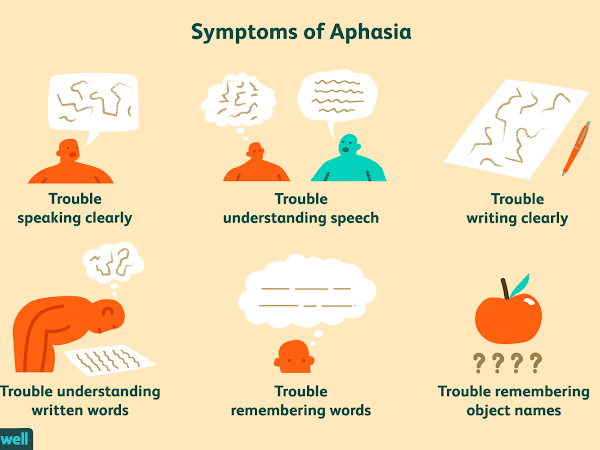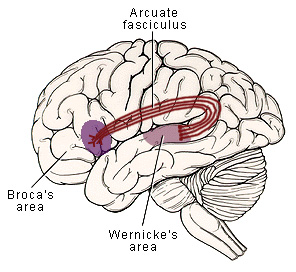Patients with Broca's diseases are capable of comprehending words and phrases but are unable to distinguish between their meanings (Nushi and Juniku, 2006, p.163). Broca's complications are distinct from Wernicke's in that they do not have difficulties with fluency comprehension. This zone is responsible for syntactic issues such as grammar, the pronunciation of words and sentences using a low tone, reluctance speaking, and occasionally improper articulation of words. For instance, âAhâMondayâah Dad and Paul âand Dadâhospital. Two ahâdoctors, thirty minutes, and yesâahâhospital. And, er, Wednesdayânine a.m. And, er, Thursday, ten a.m. â physicians. Two physiciansâand ah â. 404 (Harley, 2005). Parents, family members, and the whole community are urged to practice fundamental language and short words in this scenario.
[edit] Lelong
Lelong was another of Broca's patients. Additionally, he had less productive speaking. He could only communicate in five words: 'yes,' 'no,' three,'always,' and 'lelo' (a mispronunciation of his own name). During Lelong's autopsy, a lesion in the lateral frontal lobe was identified. Broca's prior patient, Leborgne, also suffered from same injury in the same region of the frontal lobe. These two instances convinced Broca that speech was restricted to this specific region. [7]
- Recognize activities; for example, this region seems to be engaged when shadows are cast by simulated animal-like hands. This leads us to believe that this zone is involved in the interpretation of the other zones' activities. - Additionally, a portion of the ââBroca region seems to exert effect during the handling of items.
Wernicke's area damage leads in difficulties in language understanding, a disorder known as Wernicke's aphasia. Severe Wernicke's aphasia may result in a total lack of language comprehension. While speech is often fluent, it may seem to make no sense to listeners because the patients themselves are unable to comprehend what they are saying. This nonsensical speech is also referred to as jargon aphasia. Unlike persons with Broca's aphasia, individuals with Wernicke's aphasia often exhibit a blithe indifference to their disease and seem ignorant of their difficulties. The next two tabs include videos of Broca's and Wernicke's aphasics.
Broca'S Area And Wernicke'S Area Are Two Structures That
Area 47 is next to regions 44 and 45 on the ventral side. Area 47, on the other hand, does not seem to be homogenous, since it is divided into multiple sub-areas. These sub-areas are ordered latero-oribitally (Konoonva, 1935). By contrast, Economo and Koskinas (1925) discovered a caudorostral succession of cytoarchitectonic regions and their transitional forms in this region. The ventral-orbital surface mapping outside of Broca's area certainly requires more investigation. Memory is a process that requires the integration of several regions of the brain and the alteration of the characteristics of synaptic connections.
Since Pierre Paul Broca discovered deficits in two cases, language processing has been connected to Broca's region.
[6] They had lost their capacity to talk after brain damage to the posterior inferior frontal gyrus (pars triangularis) (BA45).
[7] Since then, the precise location he found has been dubbed Broca's area, and the language production shortfall has been dubbed Broca's aphasia, also known as expressive aphasia. Broca's area is currently commonly characterized in terms of the pars opercularis and pars triangularis of the inferior frontal gyrus, which correspond to Brodmann areas 44 and 45 of the dominant hemisphere on Brodmann's cytoarchitectonic map. [7] Functional magnetic resonance imaging (fMRI) has shown that language processing also involves the pars orbitalis, the third half of the inferior frontal gyrus, and the ventral part of BA6, which are now often combined into a bigger area dubbed Broca's region. [8]
We now have a better grasp of the factors that may impact language creation as a result of the finding of Broca's region.
If a person has difficulty forming speech and writing, talks repetitively, or speaks in incoherent phrases, we may now link these symptoms to injury to Broca's region.
In certain languages, such as Spanish, the link between spelling and pronunciation is extremely obvious, making it relatively easy to recover a word's pronunciation while reading it. However, in other languages, the same string of letters may be pronounced very differently in various wordsâfor example, the âoughâ in âthoughtâ, âtoughâ, âthroughâ, and âthoughâ in English, or the âarsâ in âjarsâ, âmarsâ, and âgarsâ in French. These random variants must be learned in their entirety, without recourse to logical norms.
Broca'S And Wernicke'S Area
22 Stress: The Control and Predictability of the Locus of Control This section presents the famous rat experiment reported by Dr. Jay Weiss of Rockefeller University in New York. Two rats are wired to a stressor, which delivers an electric shock to the tail. One rat can turn off the stimulus by turning a wheel, but the other rat is always exposed to the stress stimuli regardless of what it does. It is shown that the rat with more control has fewer adverse health repercussions.
As Broca's region is not only concerned with speech production, Wernicke's is not solely concerned with speech comprehension. Wernicke's aphasia patients also have difficulties identifying objects, often answering with similar-sounding terms or the names of related objects, as though they are having a tough time with their mental dictionaries". [1]Despite their location in distinct lobes, Broca's and Wernicke's regions are fairly close. They are linked via a neural tract known as the arcuate fascilicus, as well as a newly found tract. [4] [5]
Thus, the Wernicke-Geschwind model is based on the physical placement of various functional regions of the brain. By and large, this model accurately describes the basic language disorders, such as Broca's aphasia and Wernicke's aphasia. However, it does have certain restrictions. For one thing, the premise that the many regions engaged in speech processing are sequential means that each stage must be completed before proceeding to the next, which is not necessarily the case. Due to the model's inability to account for specific partial language problems, other models have been developed to solve these deficiencies. In addition to semantic memory, which enables us to maintain the multiple meanings of words, speaking requires the use of additional specialized types of memory. For instance, in order to pronounce any given phoneme in a language that you are familiar with, you must position your tongue and lips in a certain manner. They adopt this attitude unintentionally, but you must have stored it someplace in your brain.
Aphasia on a global scale [edit | source edit] Global aphasia impairs extensive cerebral regions in the (often) left hemisphere within the supply area of the arteria cerebri medium, one of the three major cerebral arteries. As a result of such severe deficits, a wide array of cognitive restrictions, including severe impairments in speech production and comprehension, arise. It is often accompanied by paraphasic symptoms and neologism to the point where only speech automatism, or repeated utterances, such as persistent repeating of words or syllables, remains feasible.
Broca'S Area And Wernicke'S Area Function
For example, it is now known that Broca's region may play a critical role in language understanding. Cooke et al. (2002) used a neuroimaging technique known as functional magnetic resonance imaging (fMRI) on participants while they were presented with written phrases that varied in their grammatical complexity and short-term memory demands.
Wernicke's aphasia is a receptive, fluent aphasia caused by injury to the Wernicke's region. While the person with aphasia is capable of linking concepts successfully, the utterances are nonsensical. On the other side, non-fluent aphasia is characterized by the use of significant words, but in a non-fluent, telegraphic manner. [Illustration to be Uploaded Soon]
Individuals who have had a neurological damage, such as a stroke or traumatic brain injury, may also exhibit speech and language difficulties, primarily but not exclusively on the left side of the brain. Aphasia is prevalent in individuals who have had left sided brain damage. All four abilities - speaking, listening, reading, and writing - may be impacted to varied degrees. If a stroke affects the areas of the brain that regulate speech muscles (tongue, mouth, and lips), speech may become slurred or delayed.
A person suffering from Broca aphasia will talk in a very simple manner. âhorse horse two fieldâhorse horse two fieldâhorse horse two fieldâhorse horse two fieldâhorse horse two fieldâhorse horse two fieldâhorse horse two fieldâhors Nota bene, the phrase horse is repeated to represent an extra numerical clue. Additionally, this demonstrates a significant connection between mathematics and communication. In contrast to Wernicke's aphasia, a person with Broca aphasia is almost always aware of the limits of their mode of communication. Both kinds are capable of comprehending what others say, particularly when simpler phrases are uttered slowly. Bibliography
















